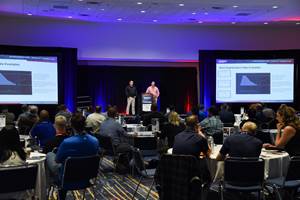Getting Specific: Narrowing Down the ISO Standards
The ISO 9001:2000 standards can be intimidating, but by breaking out what directly affects the industry, moldmakers can achieve certification faster.
The development of the Plastics ISO 9000 Model caused a revolution in the plastics supplier industry. This breakdown of the ISO standards explains in clear, simple language how to do what great toolmakers and molders do instinctively and persistently: Understand the basic building blocks of a business and use them to figure out how your company makes money and operates as a total business.
Many companies spend a lot of money on hiring people with an MBA without learning to pull these pieces of the puzzle together. Many others lack a formal business education and feel shut out from the executive suite. A plastics ISO quality model takes the mystery out of business and shows the secrets of success used by business company leaders.
Do you think that you already have a pretty good grip on what is going on at your shop/company? Great! Then answer these questions:
- What are your shop/company's sales?
- Is the shop/company growing, or is growth flat or declining?
- What is your shop/company's profit margin? Is it growing, flat or declining?
- How does your margin compare with those of your competitors? With other industries?
- What is your inventory velocity? Your asset velocity?
- What is your return on assets?
- Is your cash generation increasing or decreasing?
- Taking all of the previous questions into account, is your shop/company gaining or losing against the competition?
Toolmakers must seek constant improvements - investing in people as well as machines. Shop owners can help achieve many strategic performance goals. They have local shops that they are proud of. But it is more than their geographic proximity that makes a difference. You see, they have a certain closeness with their clients based on understanding - understanding needs, understanding goals and understanding what it takes to reach them. Independent industry-specific professionals and consultants are highly trained in working with you to develop a comprehensive quality performance plan that will help you achieve your long-term goals.
Insights to Performance Excellence
For years, many leading moldmaking and molding organizations have been using the ISO 9001 criteria to monitor processes, evaluate performance and guide improvement efforts. Many of these organizations have gained an invaluable insight into the ISO 9001 standard by using an ISO 9000 model - which can simplify the ISO 9001 criteria by offering thorough and logical explanations, while providing a clear guide to improving organizational performance.
The model presents the ISO 9001 criteria and scoring guidelines - specifically updated to reflect the changes in the 2001 criteria - along with tips on filling out the application and preparing for a site visit. The tools contained in the model will help owners and senior executives identify areas in need of improvement, set priorities and design action plans. It is a "hands-on" practical guide to people-friendly documentation, thoroughly revised to bring together practical solutions to the documentation challenges faced by today's moldmakers and molders. From shop/company policies and desk instructions to ISO 9001 requirements, the model applies a customer- and quality-based systems approach to streamlining and managing a shop/company's documentation system. A model should be an organized toolbox of powerful methodology and metrics that shows companies how to steer clear of cumbersome and obsolete documentation and gives numerous examples of the tremendous opportunities - and pitfalls - presented by technology, such as the Internet and web-based documentation management software.
There also is a guide for auditors - an easy-to-use tool for both experienced and novice plastics industry auditors who want a better understanding of the ISO 9001:2000 standard. The model explains ISO 9001 from an auditor's viewpoint, and offers examples of questions an auditor may ask during the course of an interview. The model is extremely helpful to both ISO 9001 auditors and those trying to gain a better understanding as they implement ISO 9001 within their organization. Each section of the model includes a checklist of pertinent questions that will offer further insights into the details of ISO 9001 requirements.
Details of ISO 9001 Performance Excellence
- Management systems for performance excellence (i.e., standards & regulations, Baldrige).
- Technology (business to business, business to customer, customer/supplier, Internet).
- Six Sigma. Total quality management.
- Global applications.
- Tools for performance excellence (i.e., statistics, problem solving, sampling, inspection methods, etc.).
According to the American National Standards Institute (Washington, D.C.) - a private, non-profit organization that administers and coordinates the U.S. voluntary standardization and conformity assessment system - an ISO survey for 1999 reveals the largest rise in worldwide certification: 343,643 companies reported being certified, an increase of 71,796 - or 26 percent - over the previous year. This is the highest percentage increase recorded since the survey was launched in 1993.
Expected Benefits
The immediate expected benefit of all this progress is the elimination of multiple industry quality management systems and conflicting measurement requirements. This is in line with one of the TC 176 (technical committee) guidelines for acceptance of sector specific standards - the reduction of the proliferation of additional competing requirement sets. In addition, the potential results of measurements and their use and an organized customer/supplier interface have tremendous possibilities for helping companies steer toward excellence.
A Plastics ISO 9000 model also can provide a great industry connection and lend access to resources within this cooperative environment for work on quality issues. The ability to tap this collective quality trust in search of solutions to large problems is a real advantage to ISO compliant companies. The model can demonstrate that an approach including people and culture is essential to the success of implementing lean manufacturing. Jointly optimized social and technical systems will increase the rewards of lean manufacturing - improving the bottom lines of the organizations that use them.
Related Content
Top 10 Topics to Cover During an ISO 9001 Manufacturing Audit
Take a look at this practical hands-on approach to conducting a quality audit.
Read MoreShift in U.S. Mold Imports: Emerging Countries Gain Ground in Market Share
The dynamic nature of the U.S. mold industry's global trade landscape offers challenges and opportunities for growth.
Read MoreMoldMaking Conference Session Spotlight: Data
Want to learn about digital workflows in mold design or ERP or global mold monitoring and asset management or the impact of tooling digitalization?
Read MoreVIDEO: What You Need to Know about the R&D Tax Credit Today
A team member from Strike Tax Advisory reviews the tax changes that are impacting the R&D credits for mold builders.
Read MoreRead Next
Are You a Moldmaker Considering 3D Printing? Consider the 3D Printing Workshop at NPE2024
Presentations will cover 3D printing for mold tooling, material innovation, product development, bridge production and full-scale, high-volume additive manufacturing.
Read MoreReasons to Use Fiber Lasers for Mold Cleaning
Fiber lasers offer a simplicity, speed, control and portability, minimizing mold cleaning risks.
Read MoreHow to Use Continuing Education to Remain Competitive in Moldmaking
Continued training helps moldmakers make tooling decisions and properly use the latest cutting tool to efficiently machine high-quality molds.
Read More





















